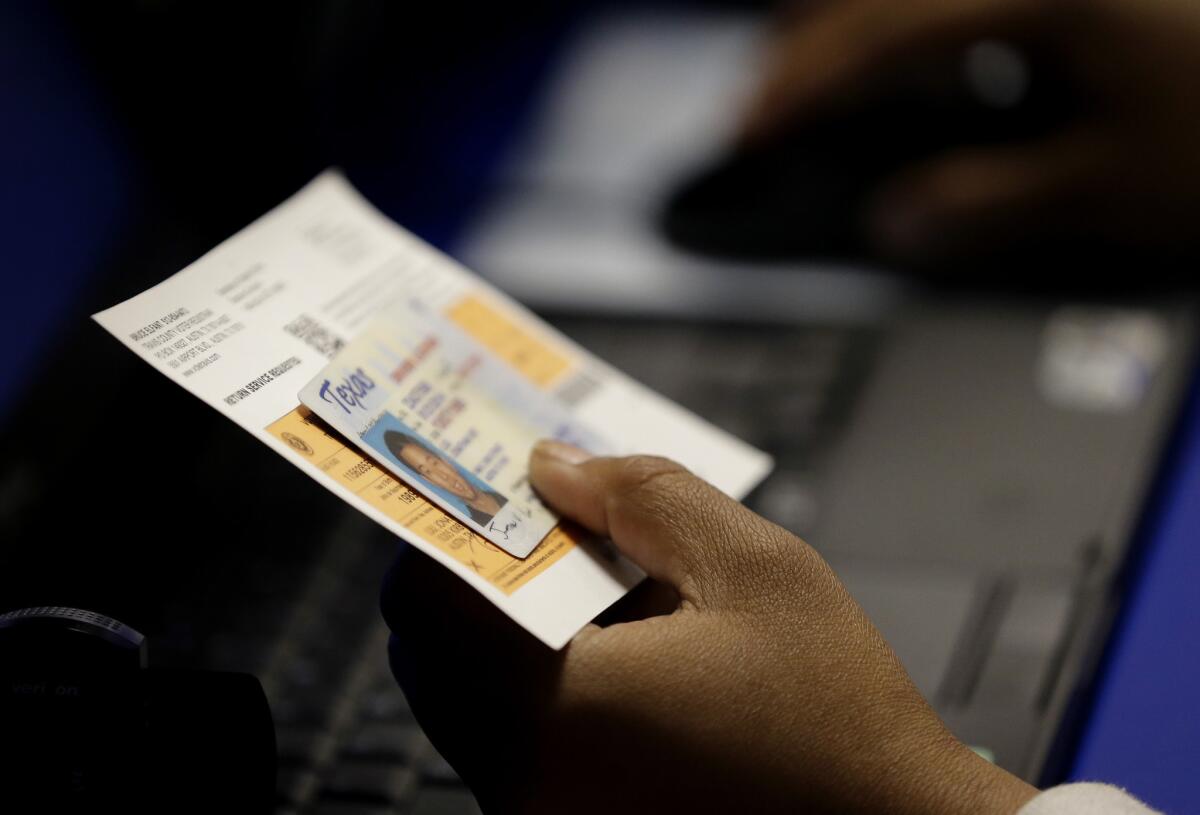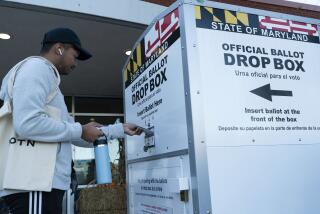Analysis: High court action on Texas ID law shows mixed record on voting rights

“There is no right more basic in our democracy than the right to participate in electing our political leaders,” Chief Justice John G. Roberts Jr. wrote in April.
Roberts spoke then for the court’s conservative majority in striking down part of a federal election law so as to allow a wealthy Republican businessman from Alabama to give more money to candidates across the country.
The contribution limit restricted the donor’s free speech, Roberts concluded, and the Constitution requires the court to err on the side of safeguarding that cherished 1st Amendment protection.
But the right to vote, which is the way most Americans participate in a democracy, has gotten far less protection from the Supreme Court under Roberts.
There is no starker example than the high court’s order early Saturday allowing Texas to enforce a new photo identification law that a federal judge had blocked earlier this month after deciding the law would prevent as many as 5% of the state’s registered voters, or 600,000 people in all, from casting a ballot.
By a 6-3 vote, the justices turned aside appeals from lawyers for civil rights groups and the Obama administration, who warned that the new law would hinder voting by blacks and Latinos. The court did not rule on the constitutionality of the law, but cleared the way for the restrictions to take effect for the November election while legal challenges work their way through the courts.
“This is an affront to our democracy,” Sherrilyn Ifill, president of the NAACP Legal Defense Fund, said in response to the order. “Today’s decision means hundreds of thousands of eligible voters in Texas will be unable to participate in November’s election because Texas has erected an obstacle course designed to discourage voting.”
A spokeswoman for the Texas attorney general praised the decision. “We are pleased that the U.S. Supreme Court has agreed that Texas’ voter ID law should remain in effect for the upcoming election,” said Lauren Bean, deputy communications director for Atty. Gen. Greg Abbott. “The state will continue to defend the voter ID law and remains confident that the district court’s misguided ruling will be overturned on the merits. The U.S. Supreme Court has already ruled that voter ID laws are a legal and sensible way to protect the integrity of elections.”
In the last decade, the high court has issued a series of rulings striking down limits on campaign contributions as 1st Amendment violations, but it has yet to issue a clear ruling upholding the constitutional right to vote.
Until recently, federal law had included strong protections against possible racial bias in elections.
Two years ago, federal judges in Washington, D.C., relying on the Voting Rights Act of 1965, barred Texas from enforcing the same photo ID law after it was first approved by the state’s Republican-controlled Legislature.
Since 1965, the civil rights law had prevented Southern states with a history of racial discrimination from changing their voting rules in a way that would make it harder for blacks or Latinos to cast a ballot. Under the law, any changes had to be preapproved by the Justice Department or federal judges in Washington before taking effect.
But last year, the Supreme Court, in an opinion written by Roberts, struck down that part of the Voting Rights Act.
“Things have changed in the South,” the chief justice said, and this “pre-clearance” rule is no longer needed and stands as an affront to states’ “equal sovereignty.”
The Texas law, like most others of its kind, has little effect on the majority of voters since those who drive already hold licenses that can serve as identification at polls. Voters in Texas may also show their permit to carry a concealed handgun or a U.S. passport.
But most voters who do not drive must go to a state motor vehicles office to obtain an acceptable photo ID and bring along a copy of their birth certificate.
And in a vast state like Texas, that may require a round trip of more than three hours, said Judge Nelva Ramos in an Oct. 9 ruling. While this is not an absolute barrier to voting, it could and probably will stand in the way of tens of thousands of fully qualified voters, she said.
Experts say many of those affected by the voter ID law are from low-income or minority communities, which tend to vote Democratic.
The Texas case was seen as a key test of whether the Voting Rights Act still stood as a barrier to racially discriminatory laws. The conservative justices who struck down the “pre-clearance” rule had said civil rights lawyers would still be able to bring lawsuits to challenge state measures that might “abridge” the right to vote based on race.
Earlier this year, a coalition of civil rights groups, joined by the Obama administration, did exactly that. They brought a suit in federal court in Texas, leading to a trial and the ruling by Ramos. She described the state’s long history of voting discrimination and concluded that the state’s Republican leaders were worried that the growing minority population could threaten their hold on power.
Her decision prevented the new law from taking effect in the upcoming election.
But Abbott, the Texas attorney general and Republican candidate for governor, quickly appealed. He denied that racial bias played any part in the enactment of the photo ID law and said the figure of 600,000 affected voters was inflated. Those who are over 65 or disabled may cast a ballot by mail, he said.
In response, the 5th Circuit Court in New Orleans lifted the judge’s order Oct. 14 and said the photo ID rule may take effect.
That set the stage for the Supreme Court to decide whether Texas could enforce the law in this year’s general election.
Lawyers for civil rights groups and the Obama administration argued in court papers that it would be “virtually unheard of” to allow a state to enforce an election law that had been struck down as racially discriminatory.
The appeals went to Justice Antonin Scalia, who oversees the 5th Circuit. Shortly after 5 a.m. Saturday, the court issued an order saying the appeals were denied. There was no explanation given.
Justice Ruth Bader Ginsburg filed a six-page dissent, which was joined by Justices Sonia Sotomayor and Elena Kagan.
Ginsburg pointed out that the Texas law has never been enforced in a federal general election. Moreover, putting the law on hold would merely restore rules that have been in effect for the last decade. Texas voters were required to show some form of identification to confirm their identity, but they could do so through a variety of means, such as utility bills.
“The greatest threat to public confidence in elections in this case is the prospect of enforcing a purposefully discriminatory law, one that likely imposes an unconstitutional poll tax and risks denying the right to vote to hundreds of thousands of eligible voters,” she wrote.
Ginsburg also noted that “racial discrimination in elections in Texas is no mere historical artifact. To the contrary, Texas has been found in violation of the Voting Rights Act in every redistricting cycle from and after 1970.”
Saturday’s outcome was hard to reconcile with an order handed down Oct. 9 that prevented Wisconsin from enforcing its voter ID law this year. The only apparent difference is that Texas argued its law had already been enforced in several primary elections, though fewer than 10% of voters participated in those elections. Suspending the law now would change the rules at the last minute, Texas officials argued.
Justices Scalia, Clarence Thomas and Samuel A. Alito Jr., who had said they would have cleared the Wisconsin law to take effect, were joined this time by Roberts, Justices Anthony M. Kennedy and Stephen G. Breyer.
On Twitter: @DavidGSavage
More to Read
Start your day right
Sign up for Essential California for news, features and recommendations from the L.A. Times and beyond in your inbox six days a week.
You may occasionally receive promotional content from the Los Angeles Times.







